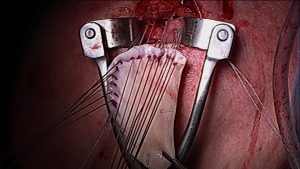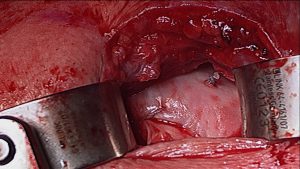Success With Grafting Technique After Severe Rotator Cuff Injury
 FIGURE 1: Rotator cuff graft pre-implantation in a different one of Toth's patients.
FIGURE 1: Rotator cuff graft pre-implantation in a different one of Toth's patients.
A 38-year-old man sustained a serious shoulder injury when he fell while replacing a light bulb in his home. Knowing that optimal treatment would be vital to ensure that he could continue his career as a head and neck surgeon, he consulted with Duke orthopaedic surgeon Alison Toth, MD.
Physical examination and findings on magnetic resonance imaging revealed that all of the patient’s rotator cuff tendons were badly ruptured. “This was such a severe injury that the only way to reconstruct his shoulder successfully was to use a graft to patch the tendons,” says Toth.
Question: After a slow start in gaining acceptance as a viable surgical option, why is this grafting technique becoming increasingly popular for repairing massive rotator cuff tears?
 FIGURE 2: Rotator cuff graft post-implantation in a different one of Toth's patients.
FIGURE 2: Rotator cuff graft post-implantation in a different one of Toth's patients.
Answers: Many studies, including Toth’s (see links below), have demonstrated that rotator reconstruction using grafts consistently results in a dramatic improvement in shoulder function, pain relief, range of motion, and muscle strength. The studies demonstrate that tendon repairs augmented with grafts stay intact in approximately 60% to 80% of individuals, which, Toth notes, is significant for large tears that otherwise can’t be repaired.
Another reason for the technique’s growing popularity is advances in the types of materials used for the graft and the way in which the materials interact with the body. With the safe, effective biologic tissues in use today, the patient’s own cells attach to the graft and regenerate the tendon. “The graft material acts like a scaffold; it eventually disappears, and a new tendon remains,” Toth explains.
Recent Research Published by Toth
Toth is at the forefront of the technique’s success, having performed it more than 500 times over 10 years while continuing to refine the procedure. She notes that although there are a number of other treatments available for repairing tears, some have poor clinical outcomes and high failure rates and others have not been widely studied. For example, conventional tendon-to-bone repair is less successful for large and massive tears, superior capsule reconstruction is a relatively new procedure that has had some demonstrated success initially and warrants further studies, and the only other option is more extreme—a total shoulder replacement. “We’re very pleased with the clinical outcomes we’re seeing from the rotator cuff grafting technique,” says Toth.
With the appropriate surgical procedure and the patient’s investment in his healing process, what could have been a career-ending injury had a very different outcome. “Not only did he have a complete recovery and regain full use of his arm,” says Toth, “but the entire experience motivated him to start an intensive fitness program just 9 months after surgery, which included strenuous shoulder exercises he had never done before. He’s now able to use the shoulder in extraordinary ways and is in the best physical shape of his life.”